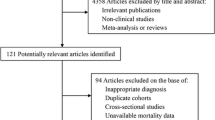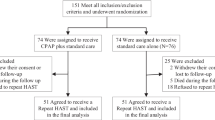Abstract
Obstructive sleep apnea (OSA) is a known-risk factor for cardiovascular diseases. There are indications that treatment with continuous positive airway pressure (CPAP) reduces the risk of new cardiovascular events. In this study, we analyzed the incidence of cardiovascular events in patients with OSA and compared for the impact of CPAP therapy. All polysomnographies performed in 2009 and 2010 were selected with an AHI ≥5 and patients older than 18 years. These 1110 patients were approached with a questionnaire about cardiovascular events and CPAP treatment. Finally, 554 patients were included in analyses. CPAP treatment was based on compliance (level 1 treatment) and extended with residual respiratory events (level 2 treatment). OSA was set as AHI ≥5 and classified in mild (AHI 5–15), moderate (AHI 15–30) and severe (AHI ≥30) OSA. 50 cardiovascular events occurred in 44 patients during follow-up (mean follow-up time 5.9 years) in 554 patients. The events were significantly higher in patients with increasing classification of OSA-severity (p = 0.016). A first-ever cardiovascular event did not differ significantly between mild, moderate and severe OSA. Untreated CPAP patients had significantly more cardiovascular events as compared to treated patients with a hazard ratio of 2.66 partially adjusted for age, AHI and smoking. There was no significant contribution of other cardiovascular risk factors. Patients with OSA with an indication for CPAP treatment have more cardiovascular events when untreated compared to treated patients. This indicates that treatment of OSA by CPAP can reduce the risk for cardiovascular events.


Similar content being viewed by others
References
Bassetti C, Aldrich MS (1999) Sleep apnea in acute cerebrovascular diseases: final report on 128 patients. Sleep 22:217–223
Wessendorf TE, Teschler H, Wang YM, Konietzko N, Thilmann AF (2000) Sleep-disordered breathing among patients with first-ever stroke. J Neurol 247:41–47
McArdle N, Riha RL, Vennelle M, Coleman EL, Dennis MS, Warlow CP, Douglas NJ (2003) Sleep-disordered breathing as a risk factor for cerebrovascular disease: a case–control study in patients with transient ischemic attacks. Stroke 34:2916–2921
Johnson KG, Johnson DC (2010) Frequency of sleep apnea in stroke and TIA patients: a meta-analysis. J Clin Sleep Med 6:131–138
Yaggi HK, Concato J, Kernan WN, Lichtman JH, Brass LM, Mohsenin V (2005) Obstructive sleep apnea as a risk factor for stroke and death. N Engl J Med 353:2034–2041
Arzt M, Young T, Finn L, Skatrud JB, Bradley TD (2005) Association of sleep-disordered breathing and the occurrence of stroke. Am J Respir Crit Care Med 172:1441–1451
Munoz R, Duran-Cantolla J, Martínez-Vila E, Gallego J, Rubio R, Aizpuru F, De La Torre G (2006) Severe sleep apnea and risk of ischemic stroke in the elderly. Stroke 37:2317–2321
Redline S, Yenokyan G, Gottlieb DJ, Shahar E, O’Connor GT, Resnick HE, Diener-West M, Sanders MH, Wolf PA, Geraghty EM, Ali T, Lebowitz M, Punjabi NM (2010) Obstructive sleep apnea–hypopnea and incident stroke: the sleep heart health study. Am J Respir Crit Care Med 182:269–277
Marin JM, Carrizo SJ, Vicente E, Agusti AG (2005) Long-term cardiovascular outcomes in men with obstructive sleep apnoea–hypopnoea with or without treatment with continuous positive airway pressure: an observational study. Lancet 365:1046–1053
Campos-Rodriguez F, Martinez-Garcia MA, Reyes-Nuñez N, Caballero-Martinez I, Catalan-Serra P, Almeida-Gonzalez CV (2014) Role of sleep apnea and continuous positive airway pressure therapy in the incidence of stroke or coronary heart disease in women. Am J Respir Crit Care Med 189:1544–1550
Iber C, Ancoli-Israel S, Chesson A, Quan SF, For the American Academy of Sleep Medicine (2007) The AASM manual for the scoring of sleep and associated events: rules, terminology and technical specifications, 1st edn. American Academy of Sleep Medicine, Westchester
American Academy of Sleep Medicine (2005) The international classification of sleep disorders: diagnostic and coding manual. 2nd edn. American Academy of Sleep Medicine, Westchester, IL
Dong J, Zhang Y, Qin L (2013) Obstructive sleep apnea and cardiovascular risk: meta-analysis of prospective cohort studies. Atherosclerosis 229:489–495
Kendzerska T, Mollayeva T, Gershon AS, Leung RS, Hwaker G, Tomlinson G (2014) Untreated obstructive sleep apnea and the risk for serious long-term adverse outcomes: a systematic review. Sleep Med Rev 18:49–59
Buchner NJ, Sanner BM, Borgel J, Rump LC (2007) Continuous positive airway pressure treatment of mild to moderate obstructive sleep apnea reduces cardiovascular risk. Am J Respir Crit Care Med 176:1274–1280
Parra O, Sanchez-Armengol A, Capote F, Bonnen M, Arboix A, Campos-Rodriguez F, Perez-Ronchel J, Duran-cantolla J, Martinez-Null C, de la Pena M, Jimenez MC, Masa F, Casadon I, Alonso ML, Macarron JL (2015) Efficacy of continuous positive airway pressure treatment on 5-years survival in patients with ischaemic stroke and obstructive sleep apnea: a randomized controlled trail. J Sleep Res 24:47–53
Barbé F, Durán-Cantolla J, Sánchez-de-la-Torre M, Martínez-Alonso M, Carmona C, Barceló A, Chiner E, Masa JF, Gonzalez M, Marín JM, Garcia-Rio F, Diaz de Atauri J, Terán J, Mayos M, de la Peña M, Monasterio C, del Campo F, Montserrat JM, For the Spanish Sleep and Breathing Network (2012) Effect of continuous positive airway pressure on the incidence of hypertension and cardiovascular events in nonsleepy patients with obstructive sleep apnea. JAMA 307:2161–2168
McEvoy RD, Antic NA, Heeley E, Luo Y, Ou Q, Zhang X, Mediano O, Chen R, Drager LF, Liu Z, Chen G, Du B, McArdle N, Mukherjee S, Tripathi M, Billot L, Biostat QL, Lorenzi-Filho G, Barbe F, Redline S, Wang J, Arima H, Neal B, White DP, Grunstein RR, Zhong N, Anderson CS (2016) CPAP for prevention of cardiovascular events in obstructive sleep apnea. N Engl J Med 375:919–931
Peker Y, Glantz H, Eulenberg C, Wegscheider K, Herlits J, Thunstrom E (2016) Effect of positive airway pressure on cardiovascular outcomes in coronary artery disease patients with non-sleepy obstructive sleep apnea: the RICCADSA randomized controlled trial. Am J Respir Crit Care Med 194:613–620
Marotta AM, Borel JC, Galerneau LM, Tamisier R, Bonsignore MR, Pepin JL (2017) Cardiovascular events in moderately to severely obese obstructive sleep apnea patients on positive airway pressure therapy. Respiration 93:179–188
Acknowledgements
We would like to thank Mark Leegstra, Irma van Velzen and Truus Ottolini-Capellen (technicians at the center for sleep and wake disorders, Medical Center Haaglanden, The Hague, The Netherlands) for their contribution.
Author information
Authors and Affiliations
Corresponding author
Ethics declarations
Funding
No funding.
Conflicts of interest
The authors declare that they have no competing interests.
Rights and permissions
About this article
Cite this article
Schipper, M.H., Jellema, K., Thomassen, B.J.W. et al. Stroke and other cardiovascular events in patients with obstructive sleep apnea and the effect of continuous positive airway pressure. J Neurol 264, 1247–1253 (2017). https://doi.org/10.1007/s00415-017-8522-z
Received:
Revised:
Accepted:
Published:
Issue Date:
DOI: https://doi.org/10.1007/s00415-017-8522-z




